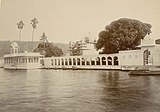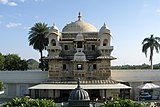
Dhebar Lake is India's first and world's oldest historical and second largest artificial fresh water lake in India. It is located in the Salumber District of Rajasthan State in western India. It has an area of 87 km2 (34 sq mi) when full, and was created at Namla Thikana (rathore-patvi) in the 17th century, when Rana Jai Singh of Udaipur built a marble dam across the Gomati River. It is about 19 km (12 mi) from the district headquarters of Salumbar. When first built, it was the largest artificial lake in the world. The surrounding Jaisamand Wildlife Sanctuary around Dhebar Lake can be reached by the state highway to Banswara from Udaipur. Jaisamand Wildlife Sanctuary protects about 162.0 square kilometres (16,200 ha), mostly teak forest, on the shores of Dhebar Lake. The lake has three islands measuring from 10 to 40 acres each. The Dhebar Lake Marble Dam is 300.0 m (984.3 ft) long and is a part of the "Heritage Monuments of India". The dam also has the Hawa Mahal Palace, winter Capital of the erstwhile Maharanas of Mewar. 1687 to 1691
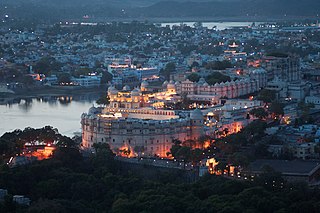
Udaipur is a city and municipal corporation in Udaipur district of the state of Rajasthan, India. It is also known as the 'City of Lakes' and serves as the administrative headquarters of Udaipur district. It is the historic capital of the kingdom of Mewar in the former Rajputana Agency. It was founded in 1559 by Udai Singh II of the Sisodia clan of Rajputs, when he shifted his capital from the city of Chittorgarh to Udaipur after Chittorgarh was besieged by Akbar. It remained as the capital city till 1818 when it became a British princely state, and thereafter the Mewar province became a part of Rajasthan when India gained independence in 1947.
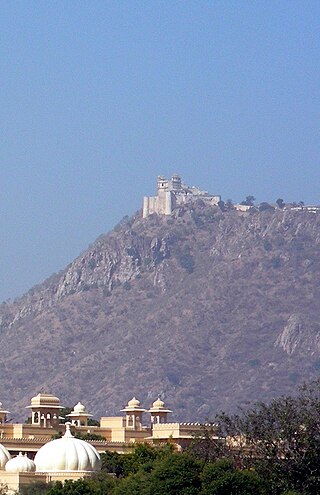
The Monsoon Palace, also known as the Sajjan Garh Palace, is a hilltop palatial residence in the city of Udaipur, Rajasthan in India, overlooking the Fateh Sagar Lake. It is named Sajjangarh after Maharana Sajjan Singh (1874–1884) of the Mewar dynasty, whom it was built for in 1884. The palace offers a panoramic view of the city's lakes, palaces and surrounding countryside. It was built chiefly to watch the monsoon clouds; hence, appropriately, it is popularly known as Monsoon Palace. It is said that the Maharana built it at the top of the hill to get a view of his ancestral home, Chittorgarh. Previously owned by the Mewar royal family, it is now under the control of the Forest Department of the Government of Rajasthan and has recently been opened to the public. The palace provides a beautiful view of the sunset.

Mahendra Singh Mewar is an Indian politician who was a Member of Parliament in the Lok Sabha. He is the eldest son of Maharana Bhagwat Singh Mewar. Mahendra and his brother Arvind both claim to be the 76th custodian of the House of Mewar. Maharanas of Udaipur are considered not rulers but custodians of the kingdom on behalf of Sri Eklingji.

Lake Palace is a former summer palace of the royal dynasty of Mewar, it is now turned into a hotel. The Lake Palace is located on the island of Jag Niwas in Lake Pichola, Udaipur, India, and its natural foundation spans 4 acres (16,000 m2). Popularly described as the Venice of the East, Udaipur hosts the pristine Lake Palace, curated out of white marble.

Shiv Niwas Palace is a former residence of the Maharana of Udaipur, Rajasthan, located on the banks of Lake Pichola.
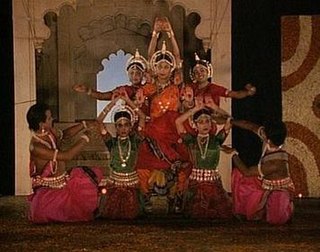
Jag Mandir, sometimes known by its subtitle, The Eccentric Private Theatre of the Maharaja of Udaipur, is a 1991 documentary film directed for television by Werner Herzog. The bulk of the film consists of footage of an elaborate theatrical performance for the Maharaj Arvind Singh Mewar at the City Palace of Udaipur, Rajasthan staged by André Heller.

The Kingdom of Mewar, sometimes known as Udaipur State, was an independent kingdom in Rajputana region of India, ruled by the Sisodia dynasty. It was established around the 7th century by the minor rulers of the Nagada-Ahar region of Udaipur and later, in the 10th century, it transformed into an independent state under Rawal Bharttripatta II.
Bhainsrorgarh Fort or Bhainsror Fort is an ancient fort that has become a major tourist spot in the state of Rajasthan, India.

City Palace, Udaipur is a palace complex situated in the city of Udaipur in the Indian state of Rajasthan. It was built over a period of nearly 400 years, with contributions from several rulers of the Mewar dynasty. Its construction began in 1553, started by Maharana Udai Singh II of the Sisodia Rajput family as he shifted his capital from the erstwhile Chittor to the newfound city of Udaipur. The palace is located on the east bank of Lake Pichola and has several palaces built within its complex.

Lake Pichola, situated in Udaipur city in the Indian state of Rajasthan, is an artificial fresh water lake, created in the year 1362, named after the nearby Picholi village. It is one of the several contiguous lakes, and developed over the last few centuries in and around the famous Udaipur city. The lakes around Udaipur were primarily created by building dams to meet the drinking water and irrigation needs of the city and its neighbourhood. Two islands, Jag Niwas and Jag Mandir are located within Pichola Lake, and have been developed with several palaces to provide views of the lake.

Maharana Sir Fateh Singh, ruled Mewar for 46 years from 1884 to 1930, with Udaipur as capital, and resided in the City Palace, Udaipur.

Rajasthan is one of the most popular tourist destinations in India, for both domestic and international tourists. Rajasthan attracts tourists for its historical forts, palaces, art and culture with its slogan "Padharo Mhare Desh " Jaipur, is also known as Pink City, is a very popular tourist destination, being the capital of Rajasthan and a part of the Golden Triangle. The Walled City of Jaipur is a UNESCO World Heritage Site and is only the second Indian city to be recognized, after Ahmedabad.
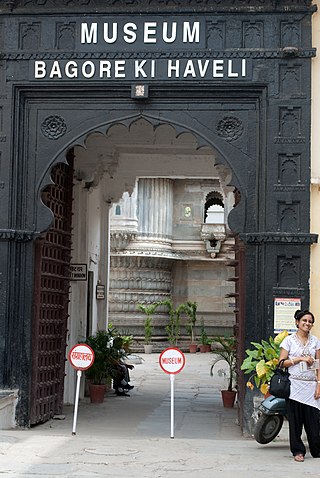
Bagore-ki-Haveli is a haveli in Udaipur in Rajasthan state in India. It is right on the waterfront of Lake Pichola at Gangori Ghat. Amar Chand Badwa, the Prime Minister of Mewar, built it in the eighteenth century.

Maharana Raj Singh I, was the Maharana of Mewar Kingdom and eldest son of Maharana Jagat Singh I. He fought against Mughal Empire and annexed many Mughal territories He later participated in Rajput War (1679–1707) and defeated Mughals.

Maharana Bhim Singh was the 26th Maharana of the illustrious house of Sisodiyas of Mewar and the 1st Maharana of the Princely state of Udaipur. He was the second son of Maharana Ari Singh II and younger brother of Maharana Hamir Singh II.

Karan Singh II was the Maharana of Mewar Kingdom. He was one of the sons of Maharana Amar Singh I and the grandson of Maharana Pratap. He, in turn, was succeeded by his son Jagat Singh I.. He succeeded his father on 26 Jan 1620 at the age of 36.

Shri Maharana Sir Bhupal Singh Bahadur KCIE, also spelt Bhopal Singh, was the ruler of the Indian princely state of Udaipur from 1930 and also Rajpramukh of Rajasthan from 1948 until his death on 4 July 1955.

Udaipur, India was founded in 1553, by Maharana Udai Singh II in the fertile circular Girwa Valley to the southwest of Nagda, on the Banas River. The city was established as the new capital of the Mewar kingdom.








